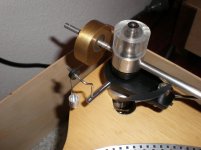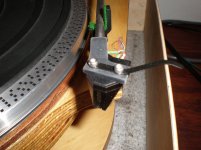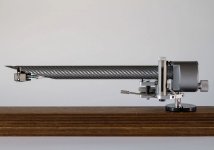I for one would follow this with much interesst! I have a Mayware V.
What carts are you thinking to optimise it for?
Regards
What carts are you thinking to optimise it for?
Regards
For a while ago I built a couple of unipivots from a thread discussing unipivots from arrows.
I would say that 12” and 16” stole the show 🙂. I too would like to make mine longer 😉!
I would say that 12” and 16” stole the show 🙂. I too would like to make mine longer 😉!
I have several cartridges, Denon DL-103M, Benz M2, Lyra Delos, Shelter 501II, Monster Cable Alpha One, Sumiko Blackbird and a very old but much loved Kotesu Rosewood. Not sure which will end up on the arm. At this point shooting for a 16" arm. Arm tube/headshell may well turn out to be wood.
Hi,
I’ve had an Mayware tonearm on a Technics SL-150 mk1 for a few weeks now.
It came with a dire Grado F1+. Not worn under the microscope but dull dull dull.
I use an AT VM740ML cartridge that can track anything. It sails through torture end-of-side tracks with ease. A few LPs I thought were knackered sound great again.
I can’t say whether it’s the stylus profile or the tonearm. Maybe both?
That same cartridge was equally successfully used on a Thorens TP16 mk2 before that—now it has an AT 150sa, not as good in my opinion.
I use a 600,000 cts silicon grease for damping.
I’ve had an Mayware tonearm on a Technics SL-150 mk1 for a few weeks now.
It came with a dire Grado F1+. Not worn under the microscope but dull dull dull.
I use an AT VM740ML cartridge that can track anything. It sails through torture end-of-side tracks with ease. A few LPs I thought were knackered sound great again.
I can’t say whether it’s the stylus profile or the tonearm. Maybe both?
That same cartridge was equally successfully used on a Thorens TP16 mk2 before that—now it has an AT 150sa, not as good in my opinion.
I use a 600,000 cts silicon grease for damping.
Last edited:
Unipivot
I have restored one of these unipivots and stuck it on a DIY turntable. I'll takes some pics and send them here.
I have restored one of these unipivots and stuck it on a DIY turntable. I'll takes some pics and send them here.
Unipivot
A friend of mine purchased this unipivot mounted on a TD150. Is was sold to him as "in very good condition". Unfortunately, the arm was a basket case. But after a lot of work, it sings.
A friend of mine purchased this unipivot mounted on a TD150. Is was sold to him as "in very good condition". Unfortunately, the arm was a basket case. But after a lot of work, it sings.
I also have a Mayware Formula Mk IV, mounted on a Thorens TD-160 Super, fitted with Denon DL103. They say this is not the best combination, but I measured the vertical resonance around 10 Hz, so it seems OK.
I filled the damping cup with a medium thick silicon grease for better damping. It does not affect tracking. I found the cartridge azimuth is critical for channel crosstalk, and it is impossible to adjust by eye. The usually recommended method is to set the top of the cartridge parallel to the record surface. I checked it with a test record that has grooves cut with 40° to 50° azimuth in 2 degrees steps. Then I set minimal crosstalk by turning the asymmetrical counterweight left or right. It is impossible to tell the difference betwen wrong and correct setting by naked eye.
I believed the arm wand is aluminium, not titanium. Is that a special version? Also my bias weight looks different.
I filled the damping cup with a medium thick silicon grease for better damping. It does not affect tracking. I found the cartridge azimuth is critical for channel crosstalk, and it is impossible to adjust by eye. The usually recommended method is to set the top of the cartridge parallel to the record surface. I checked it with a test record that has grooves cut with 40° to 50° azimuth in 2 degrees steps. Then I set minimal crosstalk by turning the asymmetrical counterweight left or right. It is impossible to tell the difference betwen wrong and correct setting by naked eye.
I believed the arm wand is aluminium, not titanium. Is that a special version? Also my bias weight looks different.
To get the azumith sort of right, I used a small bubble level.
You are correct, the original wands are aluminium. This modified one is titanium. I had to go up a size in diameter because the hole the wand slips into was ovoided, which then meant I had to turn another counterweight. I made another base plate, headshell, bucket and pulley also. The only thing difficult to make would be the stork that holds the jewel. You would then need a jeweler 🙂
I have medium viscosity silicon in the cup also.
Have you tried other arms on your Thorens?
Is the Uni-pivot your preferred arm?
You are correct, the original wands are aluminium. This modified one is titanium. I had to go up a size in diameter because the hole the wand slips into was ovoided, which then meant I had to turn another counterweight. I made another base plate, headshell, bucket and pulley also. The only thing difficult to make would be the stork that holds the jewel. You would then need a jeweler 🙂
I have medium viscosity silicon in the cup also.
Have you tried other arms on your Thorens?
Is the Uni-pivot your preferred arm?
Uni-pivots are a bit fiddley. Once you have them set up, you don't want to touch them.
Thanks for your interest.
Thanks for your interest.
I've used a Micro-Acoustics 282, ADC XLM (many) and a Sumiko Blue Point, all worked well. I have a small stash of various metric set screws if you need one or two for rebuilding / replacing. I think I identified every one, if you need a sketch of what goes where I can post that as well (it's pretty crude).
Apologies for resurrecting this thread but it seems worth keeping all of these Mayware thoughts together.
I have a Formula 4 which is installed, with Signet TK7E on a 1st gen Rega Planar3 which I've looked at with fresh eyes after reading through this thread. I bought the combo used, many years ago, from a guy who obviously was a keen hi-fier. The arm has the sliding tube weight removed and also the headshell finger lift removed.
I have a couple of questions:
1) The arm mounting includes a couple of fairly sloppy rubber gaskets. Are these worth keeping, or replacing, or just ditching completely?
2) The tube, being straight and a fairly standard 6mm o.d. could probably be easily replaced with a carbon fibre tube. Would this be a worthwhile mod?
Thanks in advance for any thoughts you may have!
I have a Formula 4 which is installed, with Signet TK7E on a 1st gen Rega Planar3 which I've looked at with fresh eyes after reading through this thread. I bought the combo used, many years ago, from a guy who obviously was a keen hi-fier. The arm has the sliding tube weight removed and also the headshell finger lift removed.
I have a couple of questions:
1) The arm mounting includes a couple of fairly sloppy rubber gaskets. Are these worth keeping, or replacing, or just ditching completely?
2) The tube, being straight and a fairly standard 6mm o.d. could probably be easily replaced with a carbon fibre tube. Would this be a worthwhile mod?
Thanks in advance for any thoughts you may have!
Reviving this thread as Basam isn't recieving PMs at the moment.
Hi Basam. Just wondering if you could provide more details about your titanium armtube, headshell and counterweight as I'd like to try making a new armtube and headshell for my JH Formula IV. What is the OD and ID and weight of the new armtube? (I know the Mayware is 6 or 7mm OD whereas the JH is 5mm.) Where did you source the titanium tube? (I'm also in Australia) Is that a custom headshell? How was that made and out of what material? What is the counterweigh made from and what is its weight? Any other info would also be appreciated.
Hi Basam. Just wondering if you could provide more details about your titanium armtube, headshell and counterweight as I'd like to try making a new armtube and headshell for my JH Formula IV. What is the OD and ID and weight of the new armtube? (I know the Mayware is 6 or 7mm OD whereas the JH is 5mm.) Where did you source the titanium tube? (I'm also in Australia) Is that a custom headshell? How was that made and out of what material? What is the counterweigh made from and what is its weight? Any other info would also be appreciated.
That looks like a nicely made head shell cut by hand from aluminium angle. Not difficult to do, just requires patience and the right tools. The Mayware is a low mass and low rigidity arm best used with highish compliance moving magnet cartridges. The sliding weight down the arm tube to set tracking force increased effective mass at higher tracking forces, theoretically making it suitable for lower compliance cartridges. But a lower compliance cartridge puts more vibration into an arm, so it ideally needs a more rigid arm.
If you're going to go to the trouble of making a new arm tube and headshell, you're also into wiring the arm (one of the harder jobs), so why not just make an entire new arm? A crude (but perfectly capable) unipivot arm is easy to make. It's when you want them to be pretty and easy to set up that it gets harder.
If you're going to go to the trouble of making a new arm tube and headshell, you're also into wiring the arm (one of the harder jobs), so why not just make an entire new arm? A crude (but perfectly capable) unipivot arm is easy to make. It's when you want them to be pretty and easy to set up that it gets harder.
Thanks EC8010 - if that's a flat piece of aluminium I'm curious to see how Basam attached it to the tube, and if he simply glued it to the original headshell to tube mount. Making a whole new arm seems like it would be alot of extra work over just making an armtube to me, but maybe after I do the armtube it will inspire me - can you recommend a good DIY unipivot arm project?
I use the JH with a AT33PTG MC cartridge and I know its not supposed to sound good and have weak bass, but it sound pretty good to me with no lack of bass at all. One of the reasons I'm interested in the titanium arm is that I'd like to see how the increased mass affects the sound, although years ago I epoxied (badly I might add) a cut down Denon PCL-30 headshell onto the armtube which weighs 5.5gms, so this may be contributing to the good bass.
I use the JH with a AT33PTG MC cartridge and I know its not supposed to sound good and have weak bass, but it sound pretty good to me with no lack of bass at all. One of the reasons I'm interested in the titanium arm is that I'd like to see how the increased mass affects the sound, although years ago I epoxied (badly I might add) a cut down Denon PCL-30 headshell onto the armtube which weighs 5.5gms, so this may be contributing to the good bass.
I'm guessing angle because a tightly drilled hole and epoxy will fix that to the tube. Unipivots range from bits of balsa wood balanced on needles (see the Altmann turntable) to carefully machined affairs. https://web.archive.org/web/20110724034020/http://www.clarisonus.com/blog/?p=72 It's all down to tool availability. Once upon a time, technical colleges used to run machining courses, giving you access to lathes etc. Or, you can buy a lathe. Beware: If you buy a lathe, you will spend the same amount again on accessories. When the SME V was introduced, I lusted after one, but it was £1200. So I bought a Hobbymat lathe and accessories (£1000), made arm and still had a lathe left over at the end.
Because inertia is proportional to distance from pivot squared, the important thing with the arm tube is not mass but rigidity. My next arm will use 19mm diameter thin wall aluminium tube salvaged from an extensible mop. Head shell (where mass is key) will be as light and rigid as possible.
The trick with epoxy is to mix it well, apply it sparingly to both (clean) surfaces, then heat it with a hair dryer to make it flow and begin curing. Then leave it in a warm place overnight.
Because inertia is proportional to distance from pivot squared, the important thing with the arm tube is not mass but rigidity. My next arm will use 19mm diameter thin wall aluminium tube salvaged from an extensible mop. Head shell (where mass is key) will be as light and rigid as possible.
The trick with epoxy is to mix it well, apply it sparingly to both (clean) surfaces, then heat it with a hair dryer to make it flow and begin curing. Then leave it in a warm place overnight.
Interesting info you linked to there especially using a biro point as a unipivot bearing - never would have thought of that. I take your point re arm mass vs rigidity however there are certain situations like mine where increasing mass may help cartridge performance. Are you suggesting that a better way to add required mass is via a heavier heashell or counterweight rather than armtube as the headshell would have greater effect being furthest from the pivot? Morch tonearms for example publish a table showing catridge weight to armtube mass selection. For my AT33PTG they recommend a blue 14gm mass arm.
http://www.moerch.dk/files/Cartridge Armtube Combination List.pdf
http://www.moerch.dk/files/Cartridge Armtube Combination List.pdf
If you need a high mass arm (perhaps for a DL103), it's better to design it using the same principles as a low mass arm, but with better rigidity (that increases mass). Thus, you don't want to add mass that purely adds mass; it must increase rigidity as well. Use the thinking required for aircraft design. So, a large diameter arm tube with a nice rigid platform for the cartridge. I prefer arm tubes > 12mm diameter. It's all about getting a balanced design and avoiding flimsy bits and heavy bits. Metal finger lifts are notoriously a problem (ringing), but a varnished cocktail stick is lighter and rings less. Sadly, most commercial arms conform to a largely unthinking design. If you decide to make your own, you don't need to conform to convention. Balsa is a very good material because of its low mass and high damping. An aluminium arm tube veneered with thin balsa (to damp its resonances) might work well. You might want to go to a longer arm length. I'm wondering about a 12" arm.
Whatever you do, make sure the leads are properly screened. There's no point in making an arm that is acoustically better if it hums. None of those silly exposed loops near the pivot seen on modern arms. Enclose as much of the wiring as possible within an earthed conductor. You can't avoid it being exposed at the cartridge pins, but there's no need for it to be exposed anywhere else. The Mayware enclosed its wiring properly.
Bass quality tends to be more about rigidity of turntable/plinth. When I added a clamp to the bottom of my Garrard 301's platter bearing to reduce flex, bass quality matched CD whereas it boomed before because the chassis flexed. If you can deflect the platter by pressing at the edge, it might be worth clamping the platter bearing.
Whatever you do, make sure the leads are properly screened. There's no point in making an arm that is acoustically better if it hums. None of those silly exposed loops near the pivot seen on modern arms. Enclose as much of the wiring as possible within an earthed conductor. You can't avoid it being exposed at the cartridge pins, but there's no need for it to be exposed anywhere else. The Mayware enclosed its wiring properly.
Bass quality tends to be more about rigidity of turntable/plinth. When I added a clamp to the bottom of my Garrard 301's platter bearing to reduce flex, bass quality matched CD whereas it boomed before because the chassis flexed. If you can deflect the platter by pressing at the edge, it might be worth clamping the platter bearing.
I agree with alot of what you say as, it appears, does Continuum looking at its Viper tonearm, also The Wand tonearm and The Pug tonearm, but for the moment I think I will stick to my much thinner Form IV arm, perhaps with a stiffer and heavier titanium armtube.
Attachments
Last edited:
- Home
- Source & Line
- Analogue Source
- Mayware Formula 4 Uni-Pivot arm




